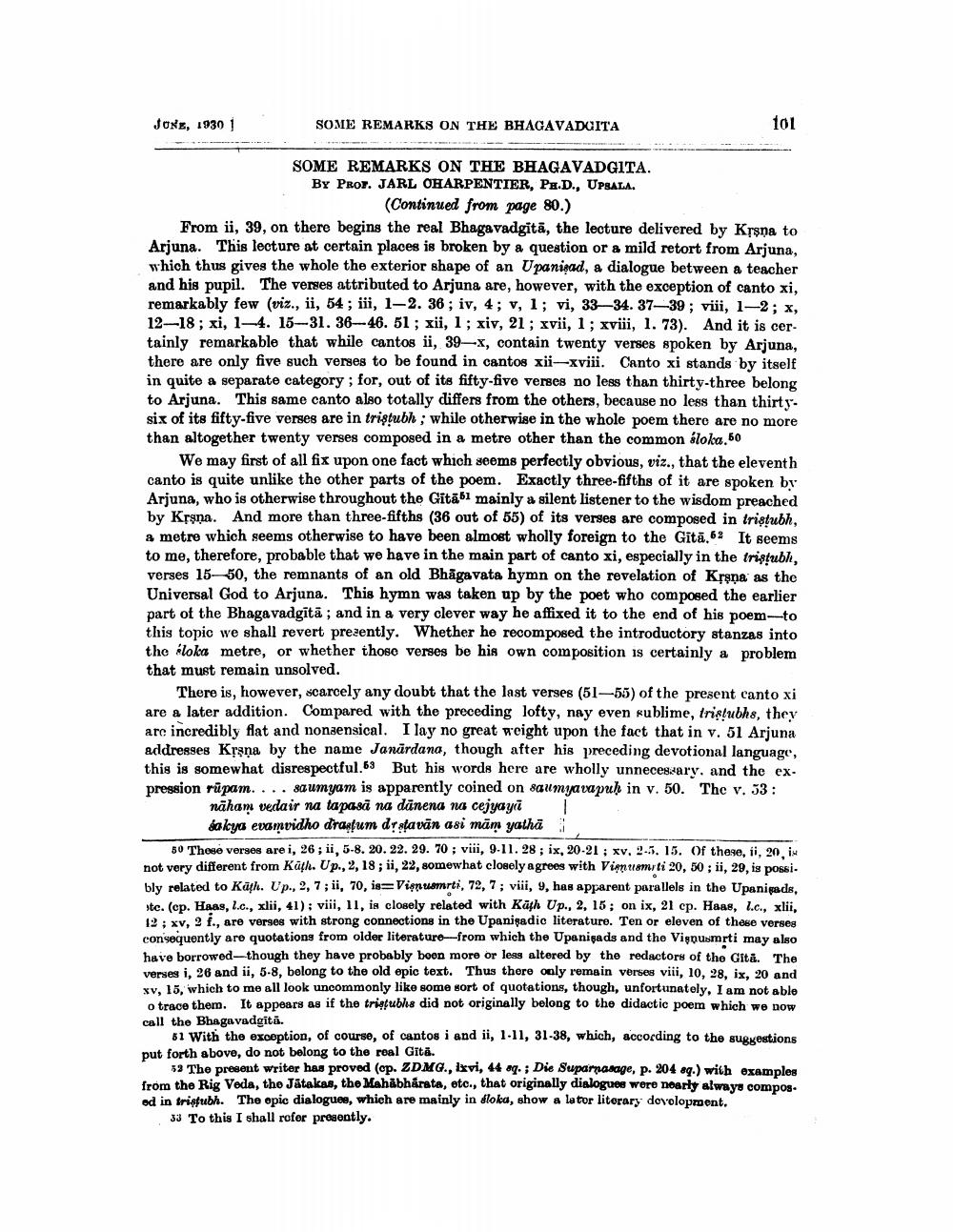________________
Joxe, 1930 1
SOME REMARKS ON THE BHAGAVADOITA
101
SOME REMARKS ON THE BHAGAVADGITA. BY PROF. JARL OHARPENTIER, PH.D., UPSALA.
(Continued from page 80.) From ii, 39, on there begins the real Bhagavadgitā, the lecture delivered by Krsna to Arjuna. This lecture at certain places is broken by a question or a mild retort from Arjuna, which thus gives the whole the exterior shape of an Upanigad, a dialogue between a teacher and his pupil. The verses attributed to Arjuna are, however, with the exception of canto xi, remarkably few (viz., ii, 54 ; iii, 1-2. 36 ; iv, 4; v, 1; vi, 33-34. 37–39; viii, 1–2; x, 12–18: xi, 1–4. 15-31. 36-46. 51; xii, 1 ; xiv, 21 ; xvii, 1; xviii, 1. 73). And it is certainly remarkable that while cantos ii, 39-, contain twenty verses spoken by Arjuna, there are only five such verses to be found in cantos xii-xviii. Canto xi stands by itself in quite a separate category; for, out of its fifty-five verses no less than thirty-three belong to Arjuna. This same canto also totally differs from the others, because no less than thirtysix of its fifty-five verses are in tristubh ; while otherwise in the whole poem there are no more than altogether twenty verses composed in a metre other than the common bloka 60
We may first of all fix upon one fact which seems perfectly obvious, viz., that the eleventh canto is quite unlike the other parts of the poem. Exactly three-fifths of it are spoken by Arjuna, who is otherwise throughout the Gitābi mainly a silent listener to the wisdom preached by Krsna. And more than three-fifths (36 out of 55) of its verses are composed in tristubh, a metre which seems otherwise to have been almost wholly foreign to the Gītā,62 It seems to me, therefore, probable that we have in the main part of canto xi, especially in the tristubh, verses 15–50, the remnants of an old Bhagavata hymn on the revelation of Krạna as the Universal God to Arjuna. This hymn was taken up by the poet who composed the earlier part of the Bhagavadgītā; and in a very clever way he affixed it to the end of his poem--to this topic we shall revert prezently. Whether he recomposed the introductory stanzas into the bloka metre, or whether those verses be his own composition is certainly a problem that must remain unsolved.
There is, however, scarcely any doubt that the last verses (51-55) of the present canto xi are a later addition. Compared with the preceding lofty, nay even fublime, tristubhs, they are incredibly flat and nonsensical. I lay no great weight upon the fact that in v. 51 Arjuna addresses Krana by the name Janārdana, though after his preceding devotional language, this is somewhat disrespectful.63 But his words here are wholly unnecessary, and the expression rüpam.... sa umyam is apparently coined on saumya wapuh in v. 50. The v. 53:
nähan vedair na tapasi na dünena na cejyayii
Sakya evamvidho dranfum dr stavän asi mām yatha 3 50 Those verses are i, 26; ii, 5-8. 20. 22. 29. 70; viii, 9-11. 28; ix, 20-21 ; xv. 2-5. 15. Of these, ii, 20. not very different from Kath. Up., 2,18; ii, 22, somewhat closely agrees with Vimtiemti 20, 50 ; ii, 29, is possi. bly related to Käth. Up., 2, 7; ii, 70, is=Vipnusmrti, 72, 7; viii, 9, has apparent parallels in the Upanigads, tc. (op. Haas, Lc., xlii, 41); viii, 11, in closely related with Käfh Up., 2, 15; on ix, 21 cp. Haas, le., xlii, 12: xv9 I., are verses with strong connections in the Upanişadio literature. Ten or eleven of these verses consequently are quotations from older literature from which the Upanipads and the Vippusmrti may also have borrowed-though they have probably boon more or less altered by the redactors of the Gita. The verses i, 26 and ii, 5-8, belong to the old epic text. Thus there only remain verses viii, 10, 28, ix, 20 and xv, 15, which to me all look uncommonly like some sort of quotations, though, unfortunately, I am not able
o trace them. It appears as if the tripfubha did not originally belong to the didactic poem which we now call the Bhagavadgitā.
81 With the exception, of course, of cantog i and ii, 1.11, 31-38, which, according to the suggestions put forth above, do not belong to the roal Gita.
53 The present writer has proved (op. ZDMG., kvi, 44 mq.; Die Suparnasage, p. 204 sq.) with examples from the Rig Veda, the Jatakas, the Mahabharata, etc., that originally dialoguee wore nearly always composed in trisfubh. The opic dialogues, which are mainly in floka, show a lator litorary development.
33 To this I shall rofer presently.




